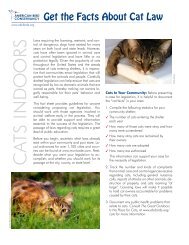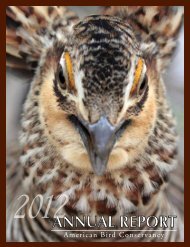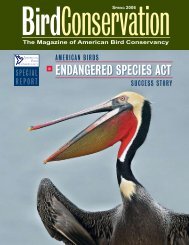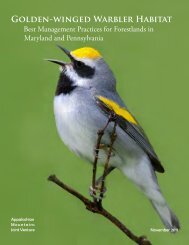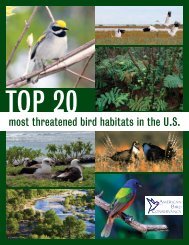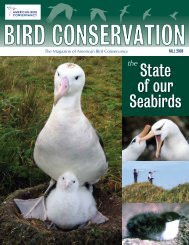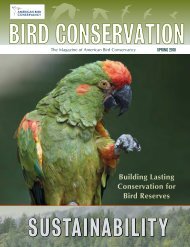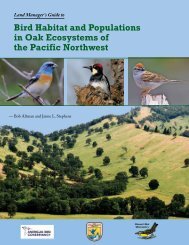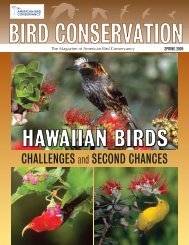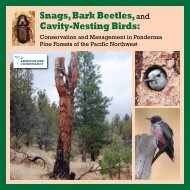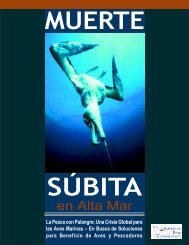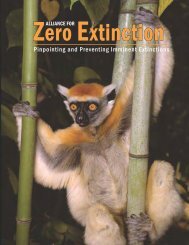Light Color and Avian OrientationStarting in the 1940s, ceilometers, powerful beamsof light used to measure the height of cloud cover,came into use, and were associated with significantbird kills. Filtering out long (red) wavelengths andusing the blue/ultraviolet range greatly reducedmortality. Later, replacement of fixed beam ceilometerswith rotating beams essentially eliminatedimpact on migrating birds (Laskey, 1960). A complexseries of laboratory studies in the 1990s demonstratedthat birds required light in order to sense theEarth’s magnetic field. <strong>Bird</strong>s could orient correctlyunder monochromatic blue or green light, but longerwavelengths (yellow and red) caused disorientation(Rappli et al., 2000; Wiltschko et al., 1993, 2003,2007). It was demonstrated that the magnetic receptorcells on the eye’s retina are inside the type ofcone cell responsible for processing blue and greenlight, but disorientation seems to involve a lack ofdirectional information.Fog increases the danger of light both by causing birds to fly lower and byrefracting light so it is visible over a larger area. Photo: Christine Sheppard, ABCPoot et al. (2008) demonstrated that migrating birdsexposed to different colored lights in the field respondthe same way they do in the laboratory. <strong>Bird</strong>swere strongly attracted to white and red light, andappeared disoriented by them, especially underovercast skies. Green light was less attractive andminimally disorienting; blue light attracted few birdsand did not disorient those that it did attract (butsee Evans et al., 2007). <strong>Bird</strong>s were not attracted to infraredlight. This work was the basis for developmentof the Phillips “Clear Sky” bulb, which produces whitelight with minimal red wavelengths (Marquenie etal., 2008) and is now in use in Europe on oil rigs andat some electrical plants. According to Van de Laaret al. (2007), tests with this bulb on an oil platformduring the 2007 fall migration produced a 50-90%reduction in birds circling and landing. Recently,Gehring et al. (2009) demonstrated that mortality atcommunication towers was greatly reduced if strobelighting was used as opposed to steady-burningwhite, or especially red lights. Replacement of steadyburningwarning lights with intermittent lights atlocations causing collisions is an excellent option forprotecting birds, as is manipulating light color.Weather Impact on CollisionsWeather has a significant and complex relationshipwith avian migration (Richardson, 1978), and largescale,mass mortality of migratory birds at tall, lightedstructures (including communication towers) hasoften correlated with fog or rain (Avery et al., 1977;Crawford, 1981b; Newton, 2007) The conjunction ofbad weather and lighted structures during migrationis a serious threat, presumably because visualcues used by birds for orientation are not available.Lower floor windows are thought to be more dangerous to birds because theyare more likely to reflect vegetation. Photo: Christine Sheppard, ABCHowever, not all collision events take place in badweather. For example, in a report of mortality at acommunications tower in North Dakota (Avery et al.,1977), the weather was overcast, usually with drizzle,on four of the five nights with the largest mortality.On the fifth occasion, however, the weather was clear.Landscaping and VegetationGelb and Delacretaz (2006, 2009) evaluated datafrom collision mortality at Manhattan building facades.They found that sites where glass reflectedextensive vegetation were associated with more collisionsthan glass reflecting little or no vegetation. Ofthe ten buildings responsible for the most collisions,four were “low-rise.” Klem (2009) measured variablesin the space immediately associated with buildingfacades in Manhattan, as risk factors for collisions.40 <strong>Bird</strong>-<strong>Friendly</strong> <strong>Building</strong> <strong>Design</strong>
Both increased height of trees and increased heightof vegetation increased the risk of collisions in fall.Ten percent increases in tree height and the heightof vegetation corresponded to 30% and 13% increasesin collisions in fall. In spring, only tree heighthad a significant influence, with a 10% increasecorresponding to a 22% increase in collisions. Confusingly,increasing “facing area” defined as thedistance to the nearest structure, correspondedstrongly with increased collisions in spring, and withreduced collisions in fall. Presumably, vegetation increasesrisk both by attracting more birds to an area,and by being reflected in glass.Research: Deterring CollisionsSystematic efforts to identify signals that can beused to make glass visible to birds began with thework of Klem in 1989. Testing glass panes in the fieldand using a dichotomous choice protocol in an aviary,Klem (1990) demonstrated that popular deviceslike “diving falcon” silhouettes were only effective ifthey were applied densely, spaced two to four inchesapart. Owl decoys, blinking holiday lights, andpictures of vertebrate eyes were among items foundto be ineffective. Grid and stripe patterns made fromwhite material, one inch wide were tested at differentspacing intervals. Only three were effective: a 3 x4 inch grid, vertical stripes spaced four inches apart,and horizontal stripes spaced about an inch apartacross the entire surface.Patterns on the outside of glass, such as that shown above, are moreeffective than patterns on an inside surface. Photo: Hans SchmidA dense internal frit pattern on the glass of the Bike and Roll building, nearUnion Station in Washington D.C., makes it look almost opaque. Photo:Christine Sheppard, ABCThis security grille also creates a pattern that will deter birds from flying toreflections. Photo: Christine Sheppard, ABCIn further testing using the same protocols, Klem(2009) confirmed the effectiveness of 3M TM ScotchcalTM Perforated Window Graphic Film (also knownas CollidEscape), WindowAlert® decals, if spaced atthe 2 x 4 rule, as above, and externally applied ceramicdots or “frits,” (0.1 inch dots spaced 0.1 inchesapart). Window films applied to the outside surfacethat rendered glass opaque or translucent werealso effective. The most effective deterrents in thisstudy were stripes of highly reflective 40% UV film(D. Klem, pers. comm., March 2011) alternating withA pattern of narrow horizontal stripes has proven to be highly effective atdeterring bird collisions, while covering only about 7% of the surface of theglass. Photo: Hans Schmid<strong>Bird</strong>-<strong>Friendly</strong> <strong>Building</strong> <strong>Design</strong>41



